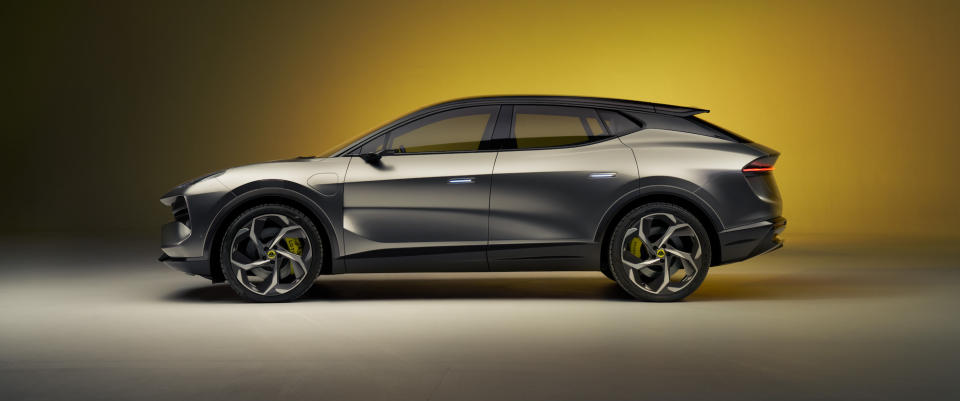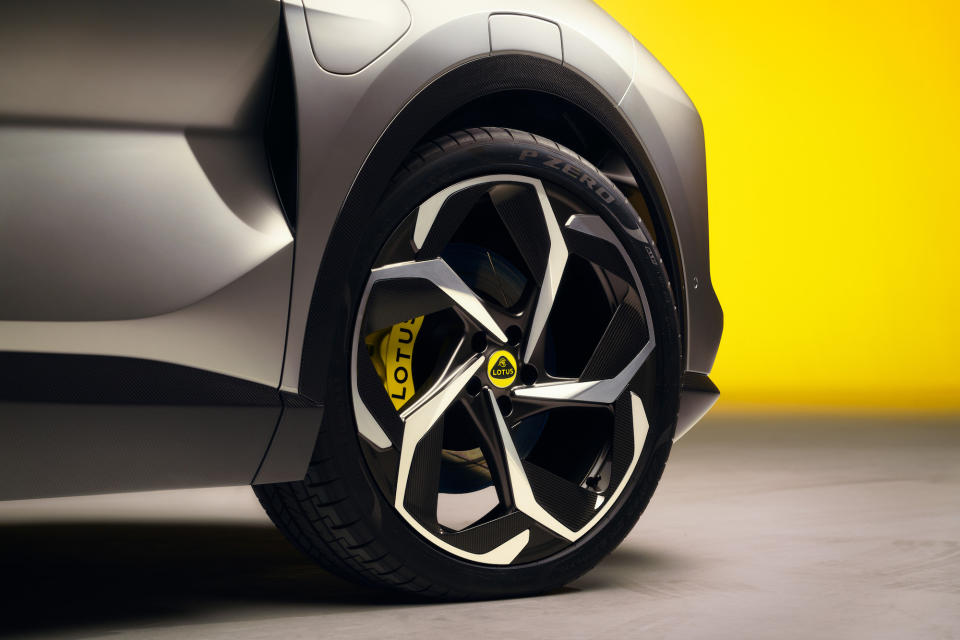The tech inside the new Lotus Eletre EV hints at autonomous driving ambitions
Lotus unveiled Tuesday a battery-electric "hyper" SUV called the Eletre -- the first of a trio of EVs Lotus plans to launch over the next four years.
The upshot? The Eletre, which means "coming to life," is the British brand's first utility vehicle and a crucial play for the anticipated boom in demand for battery-electric luxury SUVs. The vehicle's design and luxury interior features are notable. But it's some of the vehicle's tech, including a whopping four lidar sensors that pop out when needed, that provides the best glimpse of what Lotus has in store for the future.
First the basics. The company, which is owned by Geely Automotive and Malaysian conglomerate Etika Automotive, is packing in the power, torque and some decent battery range.
The Eletre has an 800-volt electric architecture, allowing for fast charging without battery degradation. There are two electric motors, one on each axle, that produce a minimum of 600 horsepower and allow the SUV to rocket from 0 to 60 mph in less than three seconds. Lotus says its battery pack, which will have more than 100-kilowatts of storage, will allow the Eletre to travel 373 miles on a full charge under the European WLTP cycle. A 350-kilowatt charger can add 248 miles in 20 minutes.
The Eletre comes with four drive modes, including one for off road, which adjusts the steering, damper settings, powertrain and accelerator pedal response. Other hardware and features can be added, such as optional 23-inch wheels, active ride height, active rear-axle steering, an active anti-roll bar and torque vectoring via braking.
The vehicle will go into production at Lotus' new facility in Wuhan, China, later this year.
Image Credits: Lotus
As Lotus' first SUV and EV, the new model "heralds a momentous point in our history and a clear signal of our ongoing desire to transform our business," according to Lotus Cars managing director Matt Windle.
The aim, of course, is for this momentous point in history to turn into momentous future profits.
Lotus did not share pricing information for the Eletre, making it difficult to precisely pinpoint its competitors. Depending on its price, it may compete with Tesla Model X or some of the more upscale SUVs that register as top-sellers for luxury brands, from Lamborghini to Aston Martin.
There's a growing list of potential competitors. Maserati announced last week plans to launch two all-electric SUVs: a battery-powered version of its Levante midsize SUV and an all-new compact crossover called the Grecale. Ferrari's first SUV, the $300,000 Purosangue, is expected later this year.
Notably, Lotus has "future proofed" the Eletre with sensors and other hardware that can be activated via over-the-air software updates to improve or add features to its advanced driver assistance system.
Lidar, the light detection and ranging sensor that is commonly viewed as the key to safely deploying autonomous vehicles, is starting to be adopted by automakers like Mercedes-Benz, Volvo and now, Lotus. These automakers see lidar as a necessary sensor to provide redundancy for specific and limited autonomous driving features, not full autonomy. At least not yet.
Image Credits: Lotus
This seems to be how Lotus intends to use lidar in the Eletre. Lotus plans to use four lidar sensors, which can be "deployed" or pop out when needed. Lotus said the lidar sensors are hidden when not required, "only emerging from the top of the windscreen, the top of the rear glass, and from the front wheel arches as required."
This lidar sensor system will eventually allow the vehicle to enter and exit parking spots via smartphone app. But comments from Maximilian Szwaj, vice president of Lotus Technology and managing director of the Lotus Tech Innovation Center in Germany, show the company is thinking beyond parking.
"ADAS technologies such as LIDAR sensors and cameras will become increasingly common on new cars as we move into a more autonomous era," he said in a statement, adding that the car has tech for today and also for tomorrow.
The vehicle will also include a camera-based mirror system, which current U.S. regulations prohibit. The three different cameras are for the rear-view mirror, a second to create a 360-degree view of the car from above to aid parking and a third used for its advanced driver assistance system. Lotus said the cameras work in tandem with the lidar system to deliver "autonomous driving capability."
Lotus doesn't provide more detail about what "autonomous driving capability" means beyond its aspirations for parking. Though the hardware Lotus describes is state of the art, there are many challenges to overcome — including a system with the compute power and software as well as an intuitive user experience — before a vehicle can have effective and safe autonomous driving features.
But four lidar sensors and three cameras suggests the company's aspirations extend to other limited or conditional autonomous driving features.
Image Credits: Lotus
Other innovations include what the company calls porosity, the principle of air flowing through the car as well as under, over and around it for better aerodynamics, range and efficiency. Lotus leaned into porosity when it designed the Evija hypercar and the Emira.
Now, the Eletre has it, which suggests that this design innovation is here to stay. Some of the more obvious examples of these air channels can be seen at the lower grille, front fenders and near the taillights.
The grille is particularly interesting, and includes a network of interconnecting triangular petals that stay shut when the car is not moving or if there's a need to reduce drag during driving. They open to feed air into the radiator, allowing the Eletre to "breathe" when cooling of the electric motors, battery pack and front brakes is required, according to Lotus.





